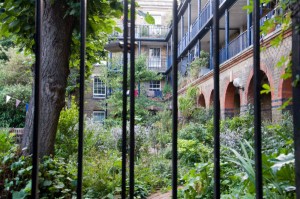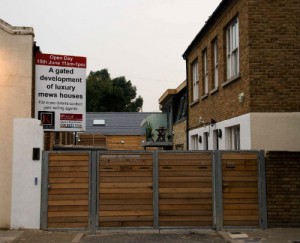
Gated communities have been a controversial topic of debate in Brixton in recent years. Our Features Editor, Keith Lewis, looks closer at their pros and cons and invites your comments.
Most weeknights throughout much of the 1980s a lady would drive from Westminster, through Brixton, bound for her neo-Georgian home in Dulwich. Her choice of house, which boasted high security gates, was symbolic to some of the increasing polarisation of a nation under her rule. The woman, you have probably guessed, was Margaret Thatcher.
Gated homes, and larger gated communities, are perhaps more topical now than during the Thatcher years. This is especially true in Brixton. Their controversy hasn’t waned and many people believe they are one obvious sign of the area’s changing demographic.
Local author, Alex Wheatle’s, short Guardian video starts with him walking past the Brockwell Gate development on Tulse Hill. He suggests that its development was a sign of the shift occurring in Brixton. And it has to be said, this is hard to argue against. But why do they arouse such controversy?
In recent history, gated communities have unsurprisingly thrived in countries with extreme wealth inequality – most notably Latin American and some Asian countries. In her book, Ground Control, Ann Minton says that the stereotype of a gated community is of luxury living “where the super-rich can live in peace and tranquillity.” She goes on to argue beyond this, however, and suggests that nowadays they are far more commonplace.
Interestingly, despite Thatcher’s seemingly prophetic choice of gated home back in the eighties, it was during New Labour’s tenure that gated developments became more commonplace in the UK. And far from being the exclusive domain of the super-rich seeking control over their own security, it appears that gated communities have indeed become more accessible.
David Blunkett, Home Secretary at the time, personally sought the expansion of gated communities so as to make them more accessible. He saw them as a way to improve social cohesion and security. At the same time, however, Ian Blair, Deputy Commissioner of the Met, expressed unequivocally that this was a dangerous idea, saying they are “invidious for social cohesion.”

Nonetheless, in the UK they have become increasingly popular and we bear witness to this fact in Brixton. A common place statement is “not another gated community’ and I for one have caught myself thinking it. To me, the term “gated community” has always sounded a bit of an oxymoron. The idea of cutting yourself off from the outside world, through fear of crime, or aspirations of exclusivity, does seem to sit uncomfortable with the wider notions of community.
However, not everybody sees it this way. One resident of a modest privately owned gated community was keen to point out to me that as part of an old warehouse, the gate was an original feature of the building. More importantly, she said, the children who lived within the block were able to play out in safety, free from the dangers of London’s busy roads. This would not be possible without the gates.
Blunkett’s personal enthusiasm for gated communities came from the US-born concept of Defensible Space. Its premise is to give residents a sense of control and ownership over a community. Thus, Blunkett was advocating a kind of micro-level localism through self-contained communities that would take pride in, and look after, their immediate locality.
One such example might be the St. George’s Residence on Railton Road. It is a council-owned residence. The well-kempt communal space is an oasis of greenery and is the proud domain of residents, who have formed an association to tend to it.
Even the residency’s urban entrance area out front has a piece of artwork hanging on an outside wall and a modern mural painted onto the large metal storage container in the grounds. Such communal aesthetic pride, particularly in unowned properties, is undeniably unique. I spoke to one long-term resident who told me proudly that she wished everybody could live in this type of gated environment, because of these benefits.
The other claim around defensible space is that it repels the possibility of crime. If this were true then can living in a gated community have a detrimental effect on communities at large, by increasing resident’s fear of crime and the outside world?
It is argued by some that the defensible space concept has often been used as an excuse to create gated communities by private developers. There is certainly no shortage of examples to choose from in Brixton.

I made some enquiries. The homes in a new, gated development off Dalberg Road have all been sold. I was told by one of its agents that, in general, gated communities such as this tend to sell for a bit more because of the added security and the fact that they often come with a parking space. So, the addition of a gate on the front of a development is undoubtedly a good investment for a developer.
All sorts of effortlessly disparaging words like notorious, or edgy, have been used to describe areas of London (including, of course, Brixton). But because of the economic ripple effect of increasing urbanisation, are people quite genuinely being driven into areas that they would not have considered a few years before? Could it be argued that gated communities lure middle and upper income groups into more urban areas, therefore?
Certainly, there seems to have been a surge in private developments that promote themselves as gated. And they definitely sit on a higher branch of the socio-economic scale, even if not right at the top of the tree.
One thing is clear. We cannot talk of gated communities without being aware of their history and their different contexts. But it does seem obvious that whilst they are more widely available, certainly in terms of private housing, they still remain an accessory that is unaffordable to most, whatever has caused the surge in their popularity.
We invite you to comment and discuss below.



And then you read stuff like this http://www.theguardian.com/society/2013/oct/22/unsocial-housing-gates-within-gates
Note that Wheatle was standing outside Bristowe Close when he made his remarks about gentrification.
Bristowe Close is the one third of Brockwell Gate development that is social housing, managed by Metropolitan Housing Trust.
But never let the facts get in the way of a good story.
Great article. However, I think the milk snatching lady either never moved into her house in Dulwich or was only there after she left Downing street.
Some of the gated communities in the countries Matthew mentioned are more like citadels, with private security and, in some cases, their own schools and hospitals. Surely here in crowded London (where many people don’t have gardens) we’re talking about having fenced-off areas where parents can send their kids to play without having to worry about them getting flattened by traffic.
Is it not also because housing is being squeezed into ever decreasing gaps, due to overpopulation and increasing land prices / demand?
Look at the ‘mews’ development in this article – it’s not properly served by a public road, so by necessity is a private area…
Sounds like similar happened to Geraldine?
For those of you lauding the merits and advantages of gated communities for those who live in them, the other side of the coin is that all these gated communities do in the long-run is aggravate the problem(s) they try to block out. Segregation and living in ivory towers to flee the “riff-raff” has never been, and will never be, a healthy long-term solution to creating a cohesive and solidarity-based society.
By blocking out people you deem uncouth, barricading yourselves in to your self-satisfied gated communities and disengaging from the wider community; you’re only aggravating your own children’s prospects because they’ll live in an even more fragmented and acrimonious society.
Look at the countries with the highest proportion of gated communities in the world (South Africa, Nigeria, Guatemala) and you’ll notice that you probably wouldn’t choose to live in any of them when compared to countries without many gated communities (Denmark, Costa Rica, Thailand). Creating gated communities is a selfish, quick-fix and ineffective solution, while wider community engagement, empathy and understanding lead to a better outcome for everyone in the long run.
Urbanspaceman:
really don’t mind which class anyone belongs to. The point I was making is in relation to the destruction of valuable resources for the sake of gentrification. They could have achieved that and still kept the two community centres. May your joys be many and your sorrows be few.
I don’t understand the opening paragraph. For most of the 1980s Mrs Thatcher lived at 10 Downing Street, as Prime Ministers do. The Thatchers bought the Dulwich house in 1986 and moved in on the day after she left office in 1990. They only lived there a few months, sold up and moved to Belgravia that same year.
Granted, virtuous people experience quite a rush when they can find a way of blaming Thatcher for things that they disapprove of; but surely just making stuff up completely so that you can squeeze in a Thatcher angle is a bit much ?
Thank you!
Re: various comments below about kids playing in the streets – you might be interested in this article on Play Streets from a few weeks back – good to see Shakespeare Road using the scheme to close their road off this weekend!
https://brixtonblog.com/getting-children-back-onto-the-streets/15178
Thanks Ed, I saw that at the time and passed it on to various people who were interested including my local Cllr. All good stuff, but they do take a lot of forward planning and need permissions. Whereas gated comms don’t.
The vast majority of people in Brixton do not live in ‘gated communities’ and are not plagued by alcoholics, beggars, druggies or marauding traffic. Ironically two community centres were demolished to ‘prettify’ the entrance to St George’s Residence. As you enter the Residence from the street there used to be a Women’s Centre on the left side and The South London Gay Community Centre on the right now buried under flagstones. I personally was involved in the Gay Centre and felt it and the Women’s Centre to be a greater social resource and more important facility than gentrifying the environment for middle class consumption.
Ian
Can you help me out a bit ? I would find it really helpful if you could let me know what the signs of being middle class are. Because I suspect that I may be middle class. If that turns out to be the case, is there anything I can do about it ? What can I do to join the same class as you ? I don’t know what class you’re in, but presumably it’s better than being middle class, so that would work for me.
Well I have had my fare share of overspill I can tell you, perhaps we do not live in the same Brixton. And it makes me sad that in the past year I have never once been able once to sit outside of a bar of restaurant without aggressive beggars. There is not one stretch of grass with a bench in the area that is not resided by drunks, not that I can think. I therefore completely understand anyone wanting to live in a place that protects their benches from this scourge.
My house is in a classic late-Victorian grid layout of streets with the frontage almost on the pavement. I have never felt unsafe because there is always through traffic (whether cars or people) and everyone can see everyone else – the notion that “gated communities” are safer because they are walled off seems questionable.
You might feel safer, but how many kids do you see playing in your street with its through traffic? I hardly ever see any in my street. And the local park (Rush Common) is largely out of bounds because it’s plagued by irresponsible owners, their dogs, sex workers and kerb crawlers. Victorian houses were built to be houses not flats – as many are these days. They weren’t built with kids and cars in mind. Gated residences don’t have to be fenced of like the last 2 pictures in the article, where, as you say, you can’t see out and no one can see in. They can be fenced using open railings like St Georges, so it’s obvious there’s nothing sinister going on – just people who live in flats enjoying the outdoors without having to worry about cars, dog mess and the occasional passing crazy person.
Quite a few, surprisingly enough.
I am reminded of a visitor from Cheshire who commented to me, on walking through Rush Common, “Park? That’s a grass verge!”
Brixton is full of hangabouts, alcoholics, and beggars, who do not even have the motivation to put their beer cans in the bins, nor walk to the Macdonalds or pub to urinate. They have now taken ownership of the once lovely Windrush Square that the council has abandoned.. Any little nook and cranny gets used in Brixton after dark for a quick fix, or sexual act. Gates are like front doors, they keep unwanted people away. Front doors keep them out of your house, and gates out of the yard or garden. Since there are so many of these people in Brixton, it makes perfect sense for private owners to want to live in a place where they have some barrier to prevent casual overspill of unwanted activity into their yard. After all, a pace or two more out onto the pavement and they have it staring in their face.
I agree – I cannot believe that after spending all that money on Windrush Square it’s been allowed to become what it has. It is full of aggressive street drinkers with absolutely no respect for their surroundings. Something needs to be done.
It is really quite impressive even allowing for Lambeth Council’s customary default attitude of negligence, lassitude and carelessness, how quickly Windrush Square has been allowed to fall apart:
1) rising bollards on Rushcroft Road failed after a few weeks
2) replaced by a red and white log, rapidly adopted as a bench for street drinkers
3) fountain which either doesn’t work or spills over
4) many broken and subsiding paving stones in front of library and Ritzy
5) damaged bicycle racks
6) damaged and threadbare grassed areas
7) broken or obscured lighting features set into steps around raised area outside Ritzy
Does anybody from Lambeth Council even bother to go through the motions of maintaining this expensive “showpiece” ?
Does anyone have a contact in the local press?. I am sure that the council would do something if the press started giving them a hard time.
Lambeth Council is unbelievably awful and immune to any sort of pressure to reform or get its act together. It’s run almost entirely to the detriment of the taxpayer and is a super-charged ideological claque that sees private capital as the enemy. The ridiculous gesture that it has made in Windrush Square in spending vast amounts of money on a god-awful public space is about the most succinct metaphor for its profligacy imaginable.
Lambeth has a planning policy against the creation of gated communities.
My nephew and niece live in a gated community. It’s lovely to see them playing outside with neighbours’ and visiting children in a safe environment – something they wouldn’t be able to do if the gate wasn’t there. They have made friends for life with kids from many different backgrounds and not just the ones they go to school with.
The families there have outdoor children’s birthday parties and street parties anytime they like, without having to get permissions from their council etc.
With more and more families bringing up kids in flats instead of houses with gardens, surely gated communal areas can only be a good thing these days.
lambeth has planning policies against lots of things but somehow they always seem to happen.
Brockwell Gate is now 13 years old and the joy of living there has more to do with the fabulous park at the back than the gates at the front!!
Some of us have ‘gated’ thrust upon us! My house is 180 years old; recently four new builds were added next door, and we have a gate. Not of my choosing, and I can see some benefits, although it’s also annoying. And we’ve lost the ability to park outside